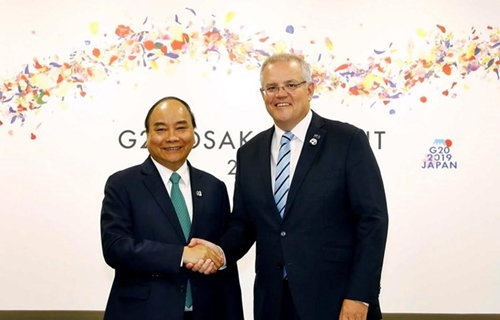In an interview granted to the Vietnam News Agency ahead of the visit, scheduled for August 22 to 24, the ambassador recalled that during the Australia visit of Prime Minister Nguyen Xuan Phuc in March last year, the two countries set up a strategic partnership, marking a new chapter in bilateral relations.
He stressed that over the past year, the two sides have implemented the five cooperation pillars stated in the Joint Statement on the establishment of the partnership.
The diplomat highlighted that the two countries have strengthened trust through regular meetings and visits at high levels, as well as exchanges between ministries, agencies and localities.
    |
 |
|
Prime Minister Nguyen Xuan Phuc (L) and Australian Prime Minister Scott Morrison at the G20 Summit in Japan |
Annual ministerial-level dialogues in the framework of the strategic partner have been held, such as the meeting of the two countries’ foreign ministers in March last year and that of defense ministers in last November. The meeting of economic ministers is slated to late this year.
At the same time, economy-trade has been the bright point in the partnership. Two-way trade reached nearly USD 7 billion in 2018 and exceeded USD 3.2 billion in the first half of 2019, up 8 percent on a yearly basis.
Australia is the 19th biggest foreign investor of Vietnam with total capital of some USD 1.9 billion. Recently, seven Vietnamese localities held a trade and investment promotion event in several Australian states and cities.
Vietnamese firms like VinGroup, TH Group and Vietjet have implemented projects in Australia.
Australian official development assistance to Vietnam has been maintained at a high level, contributing to the Southeast Asian country’s economic reform and human resources development.
The Cao Lanh bridge in the Mekong Delta province of Dong Thap, which became operational in May last year, has become a symbol of cooperation between the two countries, said the ambassador.
Regarding security-defense cooperation, he said the two sides signed a Statement on Joint Vision in 2018, shaping long-term ties between the two countries in the field.
Along with support in English training, Australia helped Vietnam transport its level-2 field hospital to South Sudan for peacekeeping operations, while sharing experience with Vietnam in the field.
Over more than a year, three naval ships of Australia visited Ho Chi Minh City port and two visited Cam Ranh port.
The two sides have supported each other in searching for missing-in-action soldiers. They have set up an annual security dialogue at deputy ministerial level, with the first meeting held in November 2018.
In science-technology, many Australian scientists have participated in research projects in Vietnam, while Australian technologies have been applied in Vietnam, especially in agriculture. Several Vietnamese fruits, including litchee, mango and dragon fruit, have been accepted in the Australian market.
At the same time, education cooperation and people-to-people exchange have been expanded, noted the ambassador, adding that about 30,000 Vietnamese students are studying in Australia, creating the fifth largest foreign student community in the country, while about 1,000 Australian students are studying in Vietnam.
In 2018, nearly 420,000 Australians visited Vietnam, while 250 Vietnamese registered to work in Australia in vacation labor programs.
Vietnam and Australia have had effective collaboration at multilateral forums, especially the ASEAN Regional Forum, the ASEAN Defense Ministers’ Meeting Plus, the East Asia Summit, the Asia-Pacific Economic Cooperation and the Asia-Europe Meeting.
Notably, after the Comprehensive and Progressive Agreement for Trans-Pacific Partnership (CPTPP) was signed earlier this year, Vietnam and Australia are working together to push for the on-schedule completion of negotiations for the Regional Comprehensive Economic Partnership (RCEP).
Australia showed strong support to Vietnam in its run for a non-permanent seat at the UN Security Council in the 2020-2021 tenure as well as Vietnam’s ASEAN chairmanship in 2020.
The two countries have also worked together in the spirit of equality, mutual respect and constructive cooperation to address issues in which they still have differences.
Ambassador Nam noted that PM Morrison chose Vietnam for a foreign visit shortly after he took his office in May 2019, which demonstrates the country’s desire to develop ties with Vietnam.
Vietnam and Australia have much room and high potential for boosting affiliation in economic issues, security and innovation.
The two countries are working closely together to become leading trade partners. Economic partnership plays a key role in the bilateral strategic partnership as Vietnam is expanding economic restructuring and international integration, creating optimal conditions for localities and businesses to broaden cooperation.
Both sides’ efforts to implement the CPTPP are also a motivation for the acceleration of trade and investment cooperation, he said.
The ambassador said the Australian PM’s visit is expected to create a new driving force and new prospects for bilateral relations, especially in science-technology, people-to-people exchange, power security, climate change response, maritime and aviation safety and security, water security, and tackling trans-national crime.
According to him, during the visit, the two sides will discuss regional and international security matters, including energy and water security, climate change, maritime and aviation security, safety and freedom.
Ambassador Nam also expressed his belief that Australia, a country playing an important role in the region, will make positive contributions to ensuring peace, stability, maritime and aviation security and safety in line with international law, especially the 1982 UN Convention on the Law of the Sea.
Source: VNA